Business Level Strategies: Analysis of Samsung Electronics Report
VerifiedAdded on 2023/06/04
|10
|2068
|274
Report
AI Summary
This report provides an analysis of Samsung Electronics' business-level strategies. It begins with an introduction to the company and its market position, followed by an examination of the five forces shaping the competitive landscape. The report delves into the bargaining power of suppliers and customers, threats from substitutes and new entrants, and the intensity of rivalry within the electronics industry. It then explores four key strategies employed by Samsung: cost leadership, innovation, differentiation, and technology-based competitive strategies. The report highlights both the successes and challenges faced by Samsung, offering insights into the company's strategic choices and their impact on its competitive advantage. The conclusion summarizes the key findings and emphasizes the importance of strategic planning in the dynamic electronics market.
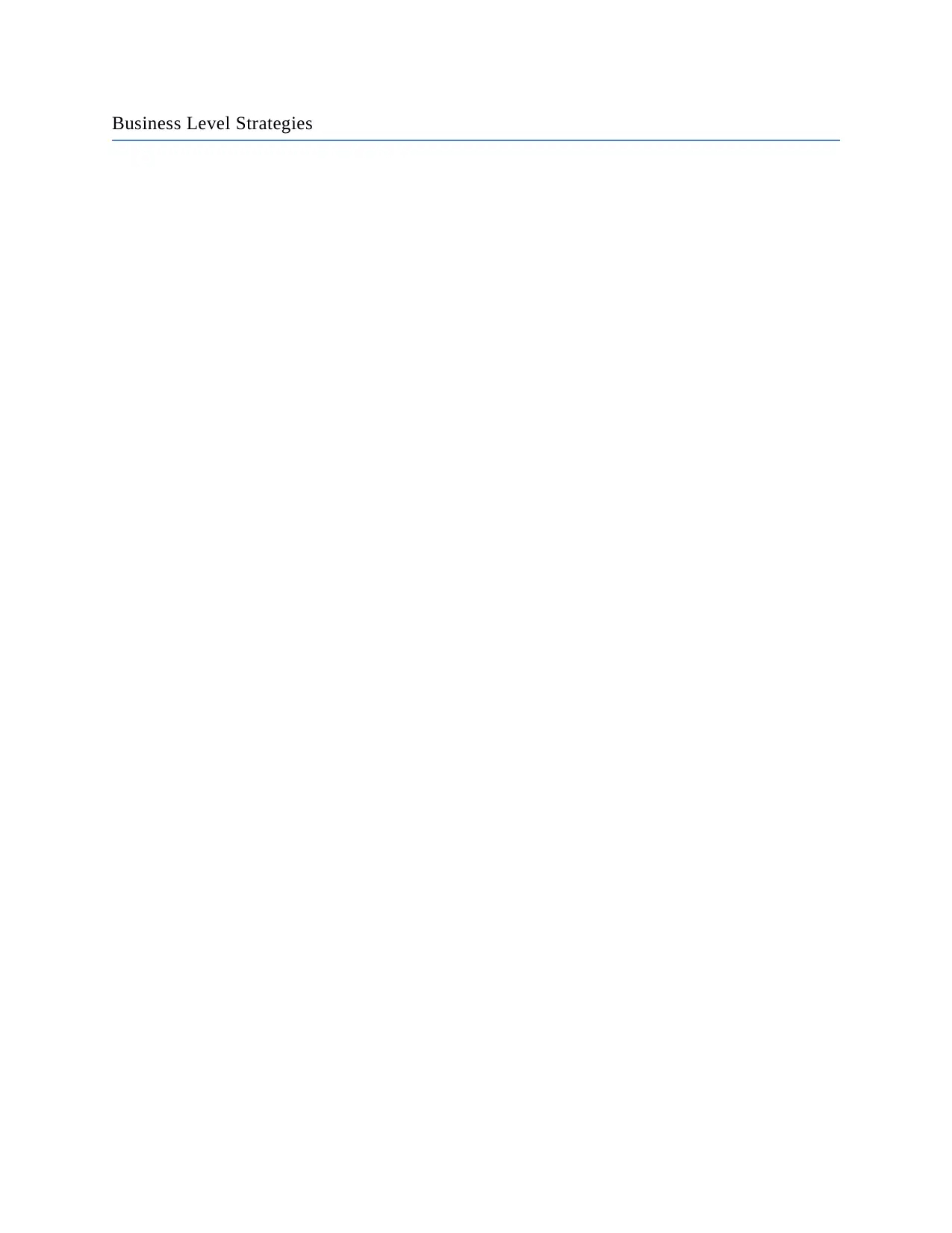
Business Level Strategies
Paraphrase This Document
Need a fresh take? Get an instant paraphrase of this document with our AI Paraphraser
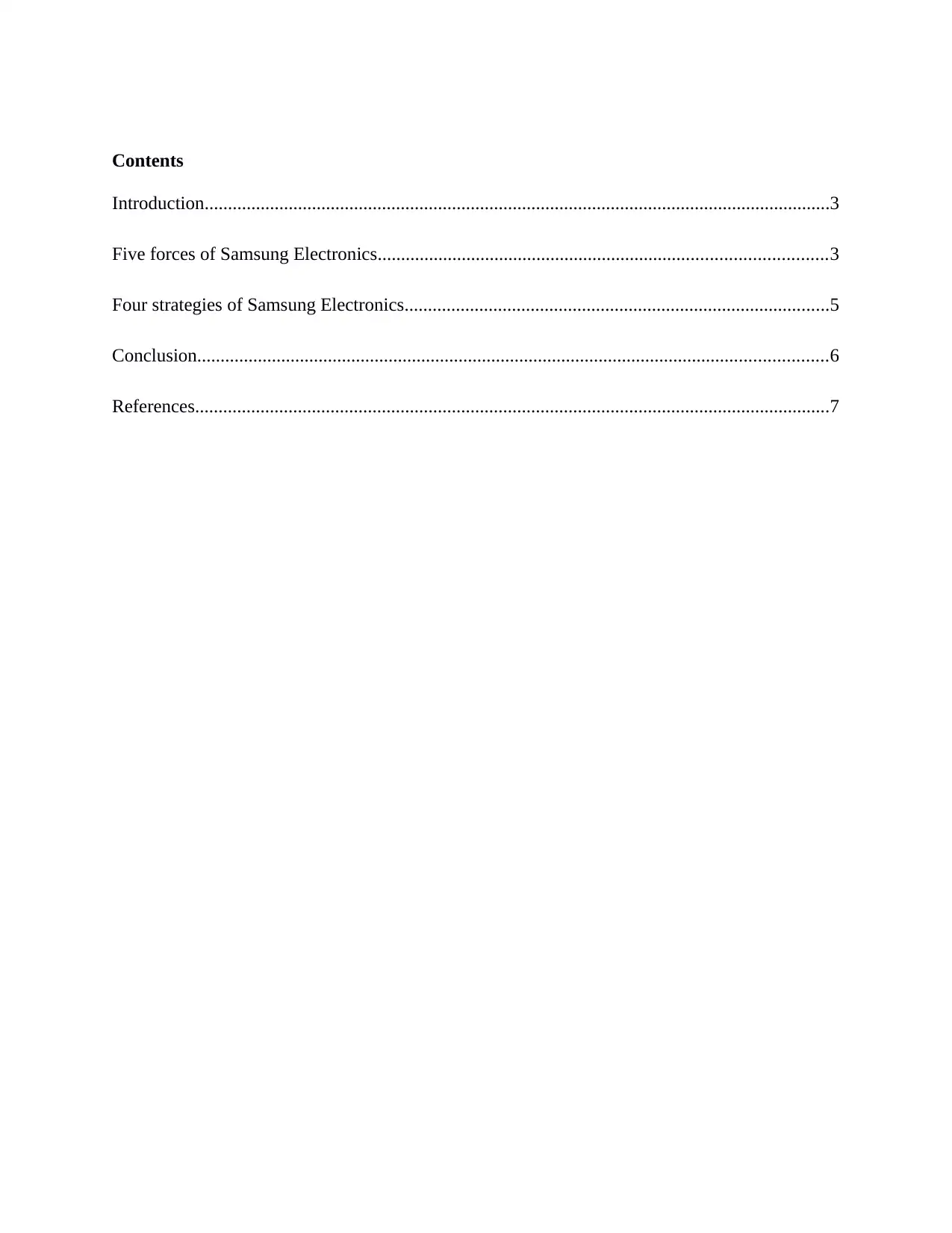
Contents
Introduction......................................................................................................................................3
Five forces of Samsung Electronics................................................................................................3
Four strategies of Samsung Electronics...........................................................................................5
Conclusion.......................................................................................................................................6
References........................................................................................................................................7
Introduction......................................................................................................................................3
Five forces of Samsung Electronics................................................................................................3
Four strategies of Samsung Electronics...........................................................................................5
Conclusion.......................................................................................................................................6
References........................................................................................................................................7
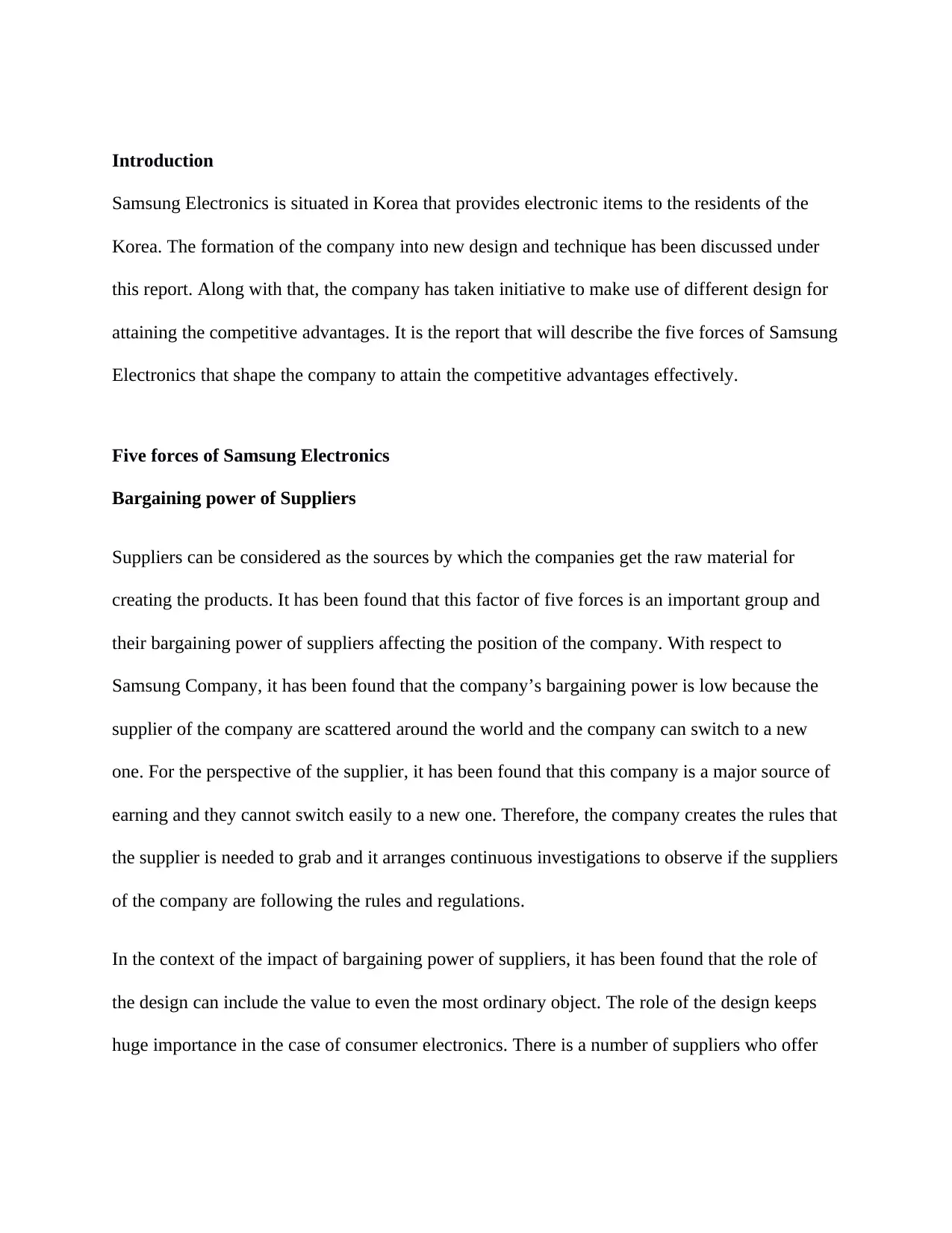
Introduction
Samsung Electronics is situated in Korea that provides electronic items to the residents of the
Korea. The formation of the company into new design and technique has been discussed under
this report. Along with that, the company has taken initiative to make use of different design for
attaining the competitive advantages. It is the report that will describe the five forces of Samsung
Electronics that shape the company to attain the competitive advantages effectively.
Five forces of Samsung Electronics
Bargaining power of Suppliers
Suppliers can be considered as the sources by which the companies get the raw material for
creating the products. It has been found that this factor of five forces is an important group and
their bargaining power of suppliers affecting the position of the company. With respect to
Samsung Company, it has been found that the company’s bargaining power is low because the
supplier of the company are scattered around the world and the company can switch to a new
one. For the perspective of the supplier, it has been found that this company is a major source of
earning and they cannot switch easily to a new one. Therefore, the company creates the rules that
the supplier is needed to grab and it arranges continuous investigations to observe if the suppliers
of the company are following the rules and regulations.
In the context of the impact of bargaining power of suppliers, it has been found that the role of
the design can include the value to even the most ordinary object. The role of the design keeps
huge importance in the case of consumer electronics. There is a number of suppliers who offer
Samsung Electronics is situated in Korea that provides electronic items to the residents of the
Korea. The formation of the company into new design and technique has been discussed under
this report. Along with that, the company has taken initiative to make use of different design for
attaining the competitive advantages. It is the report that will describe the five forces of Samsung
Electronics that shape the company to attain the competitive advantages effectively.
Five forces of Samsung Electronics
Bargaining power of Suppliers
Suppliers can be considered as the sources by which the companies get the raw material for
creating the products. It has been found that this factor of five forces is an important group and
their bargaining power of suppliers affecting the position of the company. With respect to
Samsung Company, it has been found that the company’s bargaining power is low because the
supplier of the company are scattered around the world and the company can switch to a new
one. For the perspective of the supplier, it has been found that this company is a major source of
earning and they cannot switch easily to a new one. Therefore, the company creates the rules that
the supplier is needed to grab and it arranges continuous investigations to observe if the suppliers
of the company are following the rules and regulations.
In the context of the impact of bargaining power of suppliers, it has been found that the role of
the design can include the value to even the most ordinary object. The role of the design keeps
huge importance in the case of consumer electronics. There is a number of suppliers who offer
⊘ This is a preview!⊘
Do you want full access?
Subscribe today to unlock all pages.

Trusted by 1+ million students worldwide
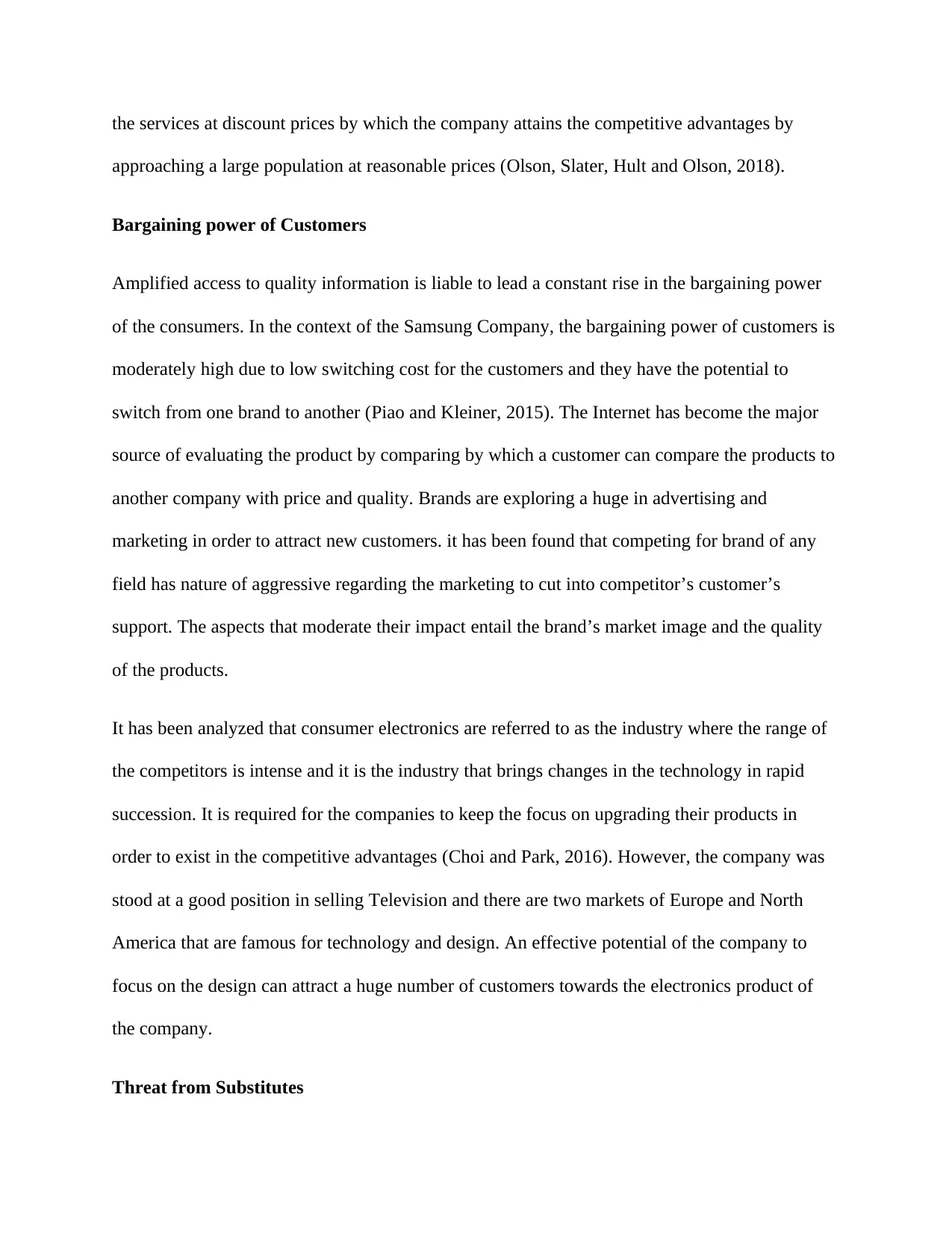
the services at discount prices by which the company attains the competitive advantages by
approaching a large population at reasonable prices (Olson, Slater, Hult and Olson, 2018).
Bargaining power of Customers
Amplified access to quality information is liable to lead a constant rise in the bargaining power
of the consumers. In the context of the Samsung Company, the bargaining power of customers is
moderately high due to low switching cost for the customers and they have the potential to
switch from one brand to another (Piao and Kleiner, 2015). The Internet has become the major
source of evaluating the product by comparing by which a customer can compare the products to
another company with price and quality. Brands are exploring a huge in advertising and
marketing in order to attract new customers. it has been found that competing for brand of any
field has nature of aggressive regarding the marketing to cut into competitor’s customer’s
support. The aspects that moderate their impact entail the brand’s market image and the quality
of the products.
It has been analyzed that consumer electronics are referred to as the industry where the range of
the competitors is intense and it is the industry that brings changes in the technology in rapid
succession. It is required for the companies to keep the focus on upgrading their products in
order to exist in the competitive advantages (Choi and Park, 2016). However, the company was
stood at a good position in selling Television and there are two markets of Europe and North
America that are famous for technology and design. An effective potential of the company to
focus on the design can attract a huge number of customers towards the electronics product of
the company.
Threat from Substitutes
approaching a large population at reasonable prices (Olson, Slater, Hult and Olson, 2018).
Bargaining power of Customers
Amplified access to quality information is liable to lead a constant rise in the bargaining power
of the consumers. In the context of the Samsung Company, the bargaining power of customers is
moderately high due to low switching cost for the customers and they have the potential to
switch from one brand to another (Piao and Kleiner, 2015). The Internet has become the major
source of evaluating the product by comparing by which a customer can compare the products to
another company with price and quality. Brands are exploring a huge in advertising and
marketing in order to attract new customers. it has been found that competing for brand of any
field has nature of aggressive regarding the marketing to cut into competitor’s customer’s
support. The aspects that moderate their impact entail the brand’s market image and the quality
of the products.
It has been analyzed that consumer electronics are referred to as the industry where the range of
the competitors is intense and it is the industry that brings changes in the technology in rapid
succession. It is required for the companies to keep the focus on upgrading their products in
order to exist in the competitive advantages (Choi and Park, 2016). However, the company was
stood at a good position in selling Television and there are two markets of Europe and North
America that are famous for technology and design. An effective potential of the company to
focus on the design can attract a huge number of customers towards the electronics product of
the company.
Threat from Substitutes
Paraphrase This Document
Need a fresh take? Get an instant paraphrase of this document with our AI Paraphraser
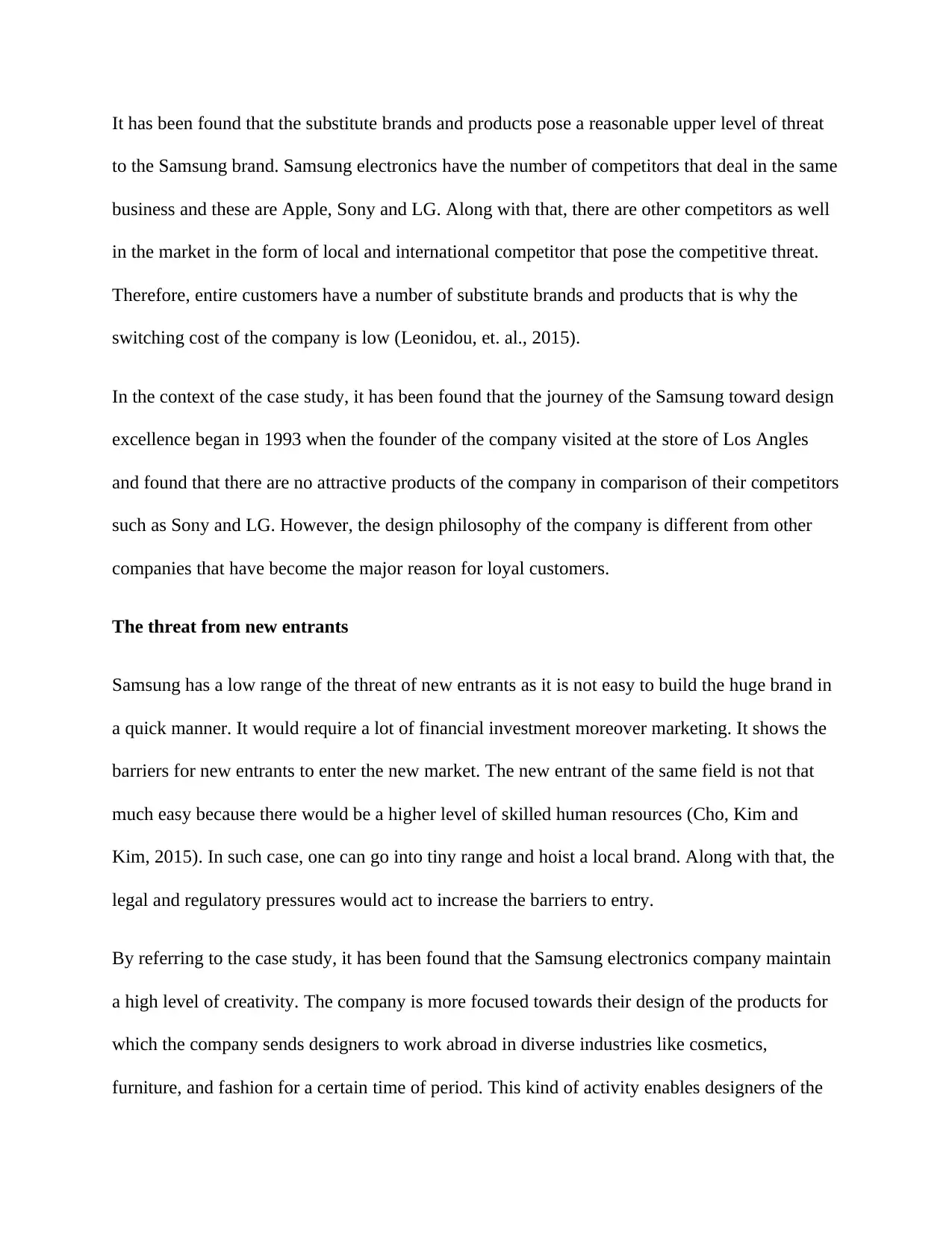
It has been found that the substitute brands and products pose a reasonable upper level of threat
to the Samsung brand. Samsung electronics have the number of competitors that deal in the same
business and these are Apple, Sony and LG. Along with that, there are other competitors as well
in the market in the form of local and international competitor that pose the competitive threat.
Therefore, entire customers have a number of substitute brands and products that is why the
switching cost of the company is low (Leonidou, et. al., 2015).
In the context of the case study, it has been found that the journey of the Samsung toward design
excellence began in 1993 when the founder of the company visited at the store of Los Angles
and found that there are no attractive products of the company in comparison of their competitors
such as Sony and LG. However, the design philosophy of the company is different from other
companies that have become the major reason for loyal customers.
The threat from new entrants
Samsung has a low range of the threat of new entrants as it is not easy to build the huge brand in
a quick manner. It would require a lot of financial investment moreover marketing. It shows the
barriers for new entrants to enter the new market. The new entrant of the same field is not that
much easy because there would be a higher level of skilled human resources (Cho, Kim and
Kim, 2015). In such case, one can go into tiny range and hoist a local brand. Along with that, the
legal and regulatory pressures would act to increase the barriers to entry.
By referring to the case study, it has been found that the Samsung electronics company maintain
a high level of creativity. The company is more focused towards their design of the products for
which the company sends designers to work abroad in diverse industries like cosmetics,
furniture, and fashion for a certain time of period. This kind of activity enables designers of the
to the Samsung brand. Samsung electronics have the number of competitors that deal in the same
business and these are Apple, Sony and LG. Along with that, there are other competitors as well
in the market in the form of local and international competitor that pose the competitive threat.
Therefore, entire customers have a number of substitute brands and products that is why the
switching cost of the company is low (Leonidou, et. al., 2015).
In the context of the case study, it has been found that the journey of the Samsung toward design
excellence began in 1993 when the founder of the company visited at the store of Los Angles
and found that there are no attractive products of the company in comparison of their competitors
such as Sony and LG. However, the design philosophy of the company is different from other
companies that have become the major reason for loyal customers.
The threat from new entrants
Samsung has a low range of the threat of new entrants as it is not easy to build the huge brand in
a quick manner. It would require a lot of financial investment moreover marketing. It shows the
barriers for new entrants to enter the new market. The new entrant of the same field is not that
much easy because there would be a higher level of skilled human resources (Cho, Kim and
Kim, 2015). In such case, one can go into tiny range and hoist a local brand. Along with that, the
legal and regulatory pressures would act to increase the barriers to entry.
By referring to the case study, it has been found that the Samsung electronics company maintain
a high level of creativity. The company is more focused towards their design of the products for
which the company sends designers to work abroad in diverse industries like cosmetics,
furniture, and fashion for a certain time of period. This kind of activity enables designers of the
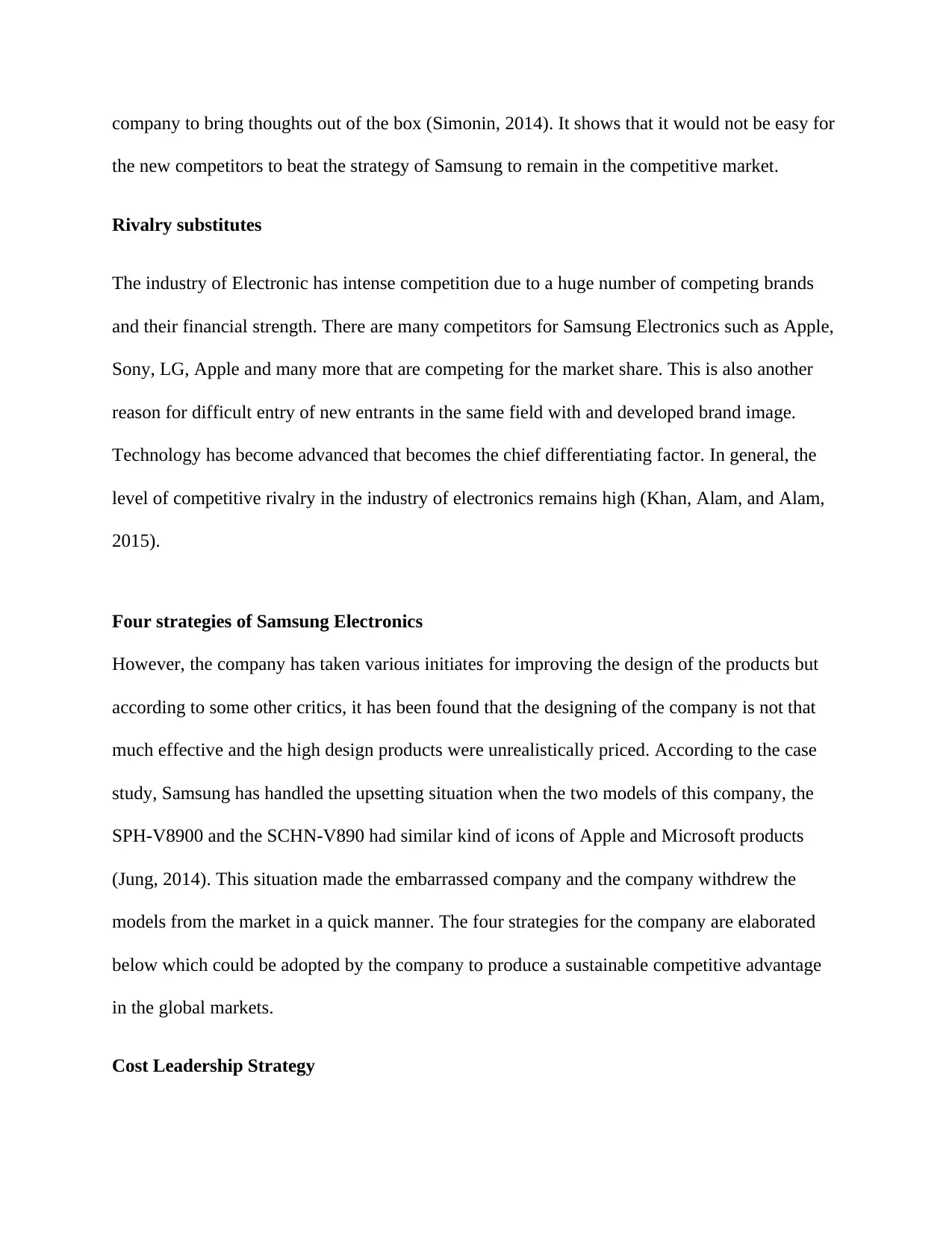
company to bring thoughts out of the box (Simonin, 2014). It shows that it would not be easy for
the new competitors to beat the strategy of Samsung to remain in the competitive market.
Rivalry substitutes
The industry of Electronic has intense competition due to a huge number of competing brands
and their financial strength. There are many competitors for Samsung Electronics such as Apple,
Sony, LG, Apple and many more that are competing for the market share. This is also another
reason for difficult entry of new entrants in the same field with and developed brand image.
Technology has become advanced that becomes the chief differentiating factor. In general, the
level of competitive rivalry in the industry of electronics remains high (Khan, Alam, and Alam,
2015).
Four strategies of Samsung Electronics
However, the company has taken various initiates for improving the design of the products but
according to some other critics, it has been found that the designing of the company is not that
much effective and the high design products were unrealistically priced. According to the case
study, Samsung has handled the upsetting situation when the two models of this company, the
SPH-V8900 and the SCHN-V890 had similar kind of icons of Apple and Microsoft products
(Jung, 2014). This situation made the embarrassed company and the company withdrew the
models from the market in a quick manner. The four strategies for the company are elaborated
below which could be adopted by the company to produce a sustainable competitive advantage
in the global markets.
Cost Leadership Strategy
the new competitors to beat the strategy of Samsung to remain in the competitive market.
Rivalry substitutes
The industry of Electronic has intense competition due to a huge number of competing brands
and their financial strength. There are many competitors for Samsung Electronics such as Apple,
Sony, LG, Apple and many more that are competing for the market share. This is also another
reason for difficult entry of new entrants in the same field with and developed brand image.
Technology has become advanced that becomes the chief differentiating factor. In general, the
level of competitive rivalry in the industry of electronics remains high (Khan, Alam, and Alam,
2015).
Four strategies of Samsung Electronics
However, the company has taken various initiates for improving the design of the products but
according to some other critics, it has been found that the designing of the company is not that
much effective and the high design products were unrealistically priced. According to the case
study, Samsung has handled the upsetting situation when the two models of this company, the
SPH-V8900 and the SCHN-V890 had similar kind of icons of Apple and Microsoft products
(Jung, 2014). This situation made the embarrassed company and the company withdrew the
models from the market in a quick manner. The four strategies for the company are elaborated
below which could be adopted by the company to produce a sustainable competitive advantage
in the global markets.
Cost Leadership Strategy
⊘ This is a preview!⊘
Do you want full access?
Subscribe today to unlock all pages.

Trusted by 1+ million students worldwide
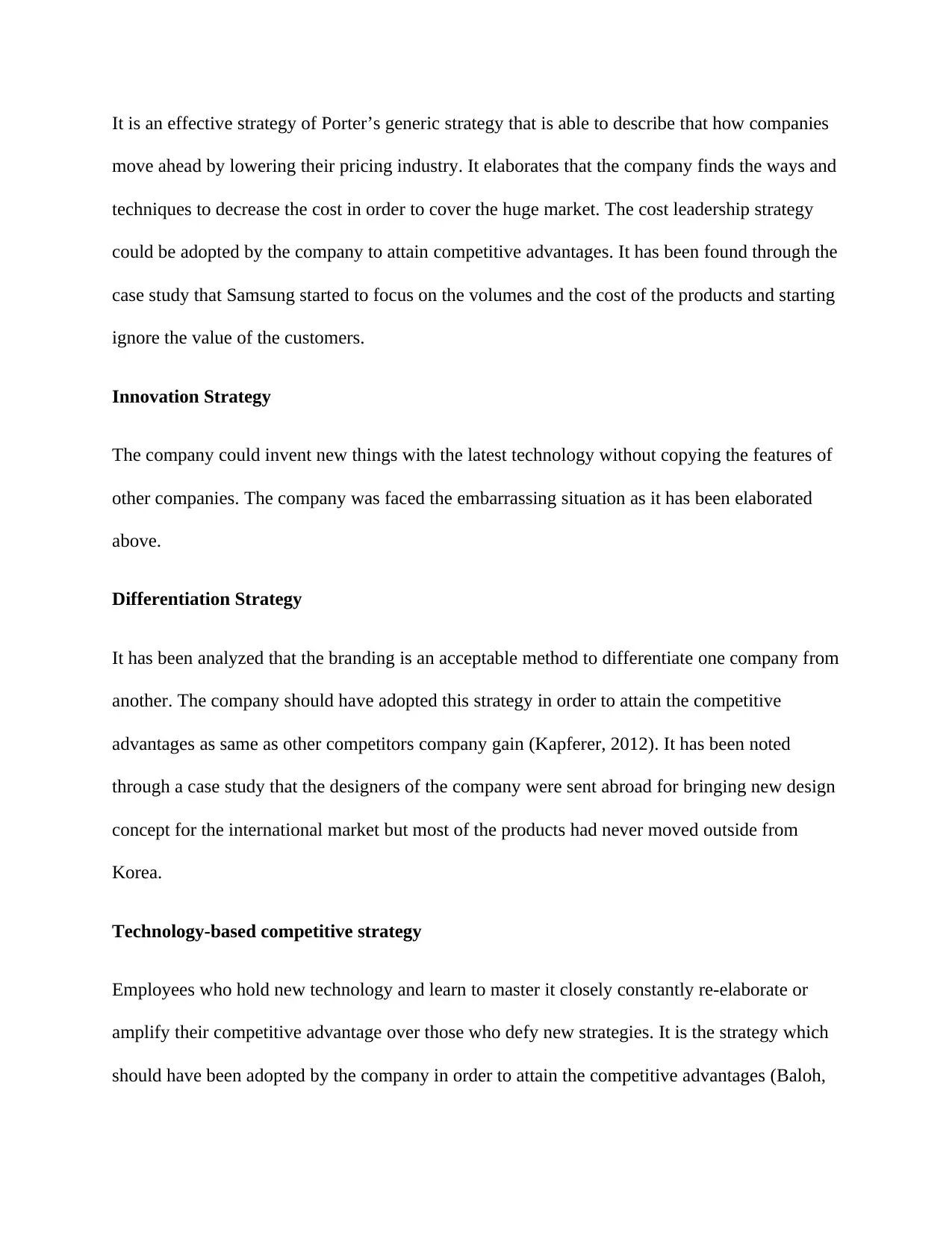
It is an effective strategy of Porter’s generic strategy that is able to describe that how companies
move ahead by lowering their pricing industry. It elaborates that the company finds the ways and
techniques to decrease the cost in order to cover the huge market. The cost leadership strategy
could be adopted by the company to attain competitive advantages. It has been found through the
case study that Samsung started to focus on the volumes and the cost of the products and starting
ignore the value of the customers.
Innovation Strategy
The company could invent new things with the latest technology without copying the features of
other companies. The company was faced the embarrassing situation as it has been elaborated
above.
Differentiation Strategy
It has been analyzed that the branding is an acceptable method to differentiate one company from
another. The company should have adopted this strategy in order to attain the competitive
advantages as same as other competitors company gain (Kapferer, 2012). It has been noted
through a case study that the designers of the company were sent abroad for bringing new design
concept for the international market but most of the products had never moved outside from
Korea.
Technology-based competitive strategy
Employees who hold new technology and learn to master it closely constantly re-elaborate or
amplify their competitive advantage over those who defy new strategies. It is the strategy which
should have been adopted by the company in order to attain the competitive advantages (Baloh,
move ahead by lowering their pricing industry. It elaborates that the company finds the ways and
techniques to decrease the cost in order to cover the huge market. The cost leadership strategy
could be adopted by the company to attain competitive advantages. It has been found through the
case study that Samsung started to focus on the volumes and the cost of the products and starting
ignore the value of the customers.
Innovation Strategy
The company could invent new things with the latest technology without copying the features of
other companies. The company was faced the embarrassing situation as it has been elaborated
above.
Differentiation Strategy
It has been analyzed that the branding is an acceptable method to differentiate one company from
another. The company should have adopted this strategy in order to attain the competitive
advantages as same as other competitors company gain (Kapferer, 2012). It has been noted
through a case study that the designers of the company were sent abroad for bringing new design
concept for the international market but most of the products had never moved outside from
Korea.
Technology-based competitive strategy
Employees who hold new technology and learn to master it closely constantly re-elaborate or
amplify their competitive advantage over those who defy new strategies. It is the strategy which
should have been adopted by the company in order to attain the competitive advantages (Baloh,
Paraphrase This Document
Need a fresh take? Get an instant paraphrase of this document with our AI Paraphraser
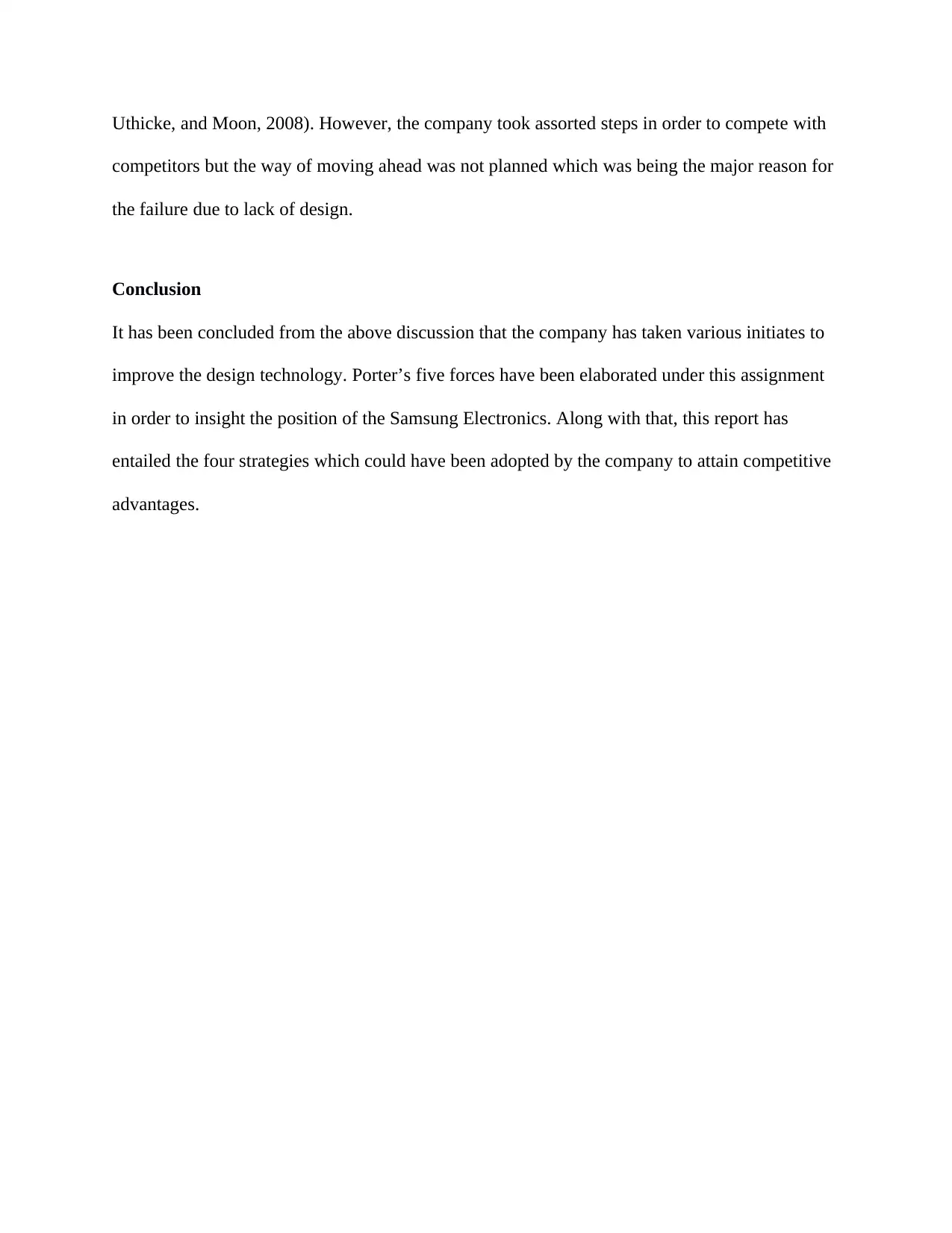
Uthicke, and Moon, 2008). However, the company took assorted steps in order to compete with
competitors but the way of moving ahead was not planned which was being the major reason for
the failure due to lack of design.
Conclusion
It has been concluded from the above discussion that the company has taken various initiates to
improve the design technology. Porter’s five forces have been elaborated under this assignment
in order to insight the position of the Samsung Electronics. Along with that, this report has
entailed the four strategies which could have been adopted by the company to attain competitive
advantages.
competitors but the way of moving ahead was not planned which was being the major reason for
the failure due to lack of design.
Conclusion
It has been concluded from the above discussion that the company has taken various initiates to
improve the design technology. Porter’s five forces have been elaborated under this assignment
in order to insight the position of the Samsung Electronics. Along with that, this report has
entailed the four strategies which could have been adopted by the company to attain competitive
advantages.
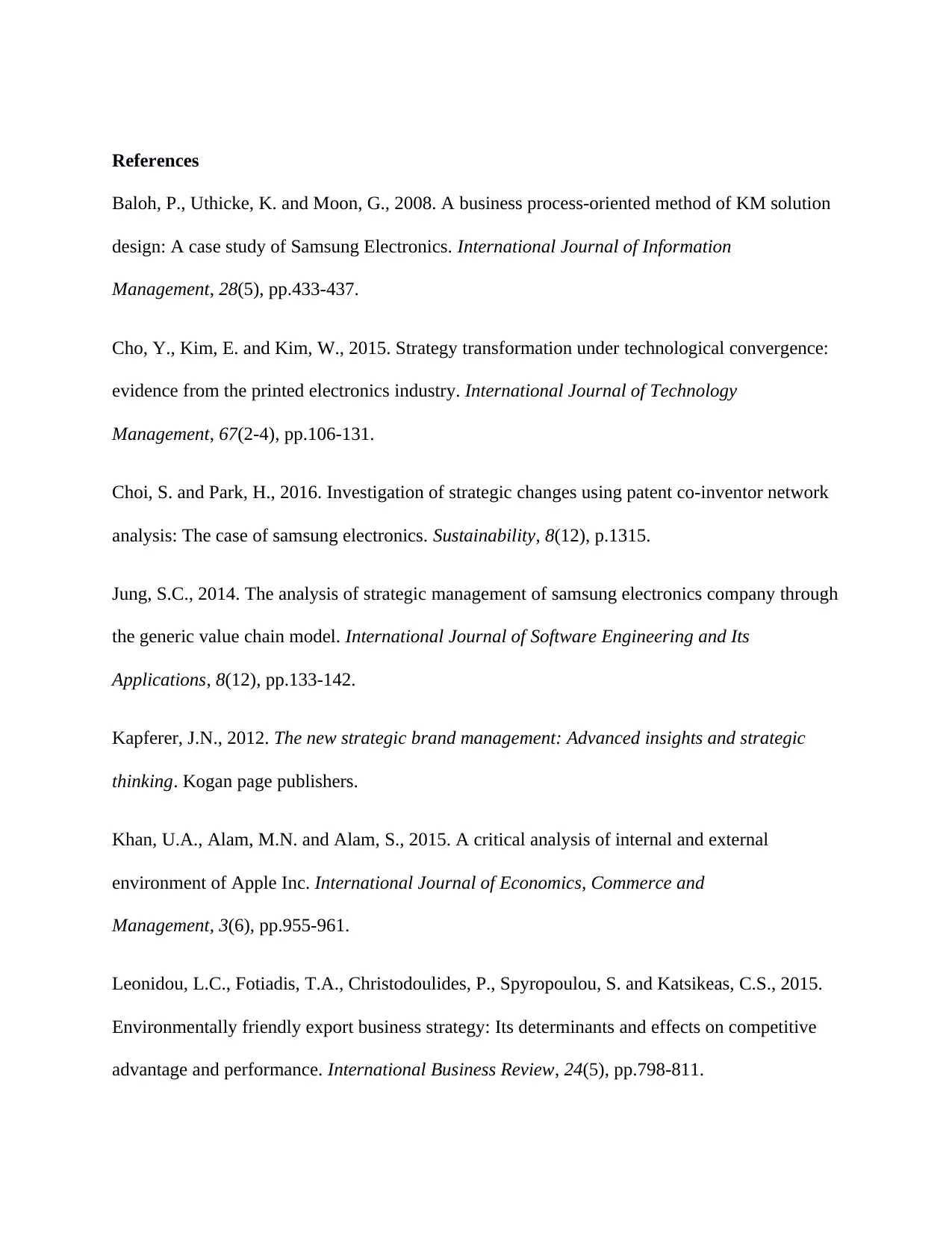
References
Baloh, P., Uthicke, K. and Moon, G., 2008. A business process-oriented method of KM solution
design: A case study of Samsung Electronics. International Journal of Information
Management, 28(5), pp.433-437.
Cho, Y., Kim, E. and Kim, W., 2015. Strategy transformation under technological convergence:
evidence from the printed electronics industry. International Journal of Technology
Management, 67(2-4), pp.106-131.
Choi, S. and Park, H., 2016. Investigation of strategic changes using patent co-inventor network
analysis: The case of samsung electronics. Sustainability, 8(12), p.1315.
Jung, S.C., 2014. The analysis of strategic management of samsung electronics company through
the generic value chain model. International Journal of Software Engineering and Its
Applications, 8(12), pp.133-142.
Kapferer, J.N., 2012. The new strategic brand management: Advanced insights and strategic
thinking. Kogan page publishers.
Khan, U.A., Alam, M.N. and Alam, S., 2015. A critical analysis of internal and external
environment of Apple Inc. International Journal of Economics, Commerce and
Management, 3(6), pp.955-961.
Leonidou, L.C., Fotiadis, T.A., Christodoulides, P., Spyropoulou, S. and Katsikeas, C.S., 2015.
Environmentally friendly export business strategy: Its determinants and effects on competitive
advantage and performance. International Business Review, 24(5), pp.798-811.
Baloh, P., Uthicke, K. and Moon, G., 2008. A business process-oriented method of KM solution
design: A case study of Samsung Electronics. International Journal of Information
Management, 28(5), pp.433-437.
Cho, Y., Kim, E. and Kim, W., 2015. Strategy transformation under technological convergence:
evidence from the printed electronics industry. International Journal of Technology
Management, 67(2-4), pp.106-131.
Choi, S. and Park, H., 2016. Investigation of strategic changes using patent co-inventor network
analysis: The case of samsung electronics. Sustainability, 8(12), p.1315.
Jung, S.C., 2014. The analysis of strategic management of samsung electronics company through
the generic value chain model. International Journal of Software Engineering and Its
Applications, 8(12), pp.133-142.
Kapferer, J.N., 2012. The new strategic brand management: Advanced insights and strategic
thinking. Kogan page publishers.
Khan, U.A., Alam, M.N. and Alam, S., 2015. A critical analysis of internal and external
environment of Apple Inc. International Journal of Economics, Commerce and
Management, 3(6), pp.955-961.
Leonidou, L.C., Fotiadis, T.A., Christodoulides, P., Spyropoulou, S. and Katsikeas, C.S., 2015.
Environmentally friendly export business strategy: Its determinants and effects on competitive
advantage and performance. International Business Review, 24(5), pp.798-811.
⊘ This is a preview!⊘
Do you want full access?
Subscribe today to unlock all pages.

Trusted by 1+ million students worldwide
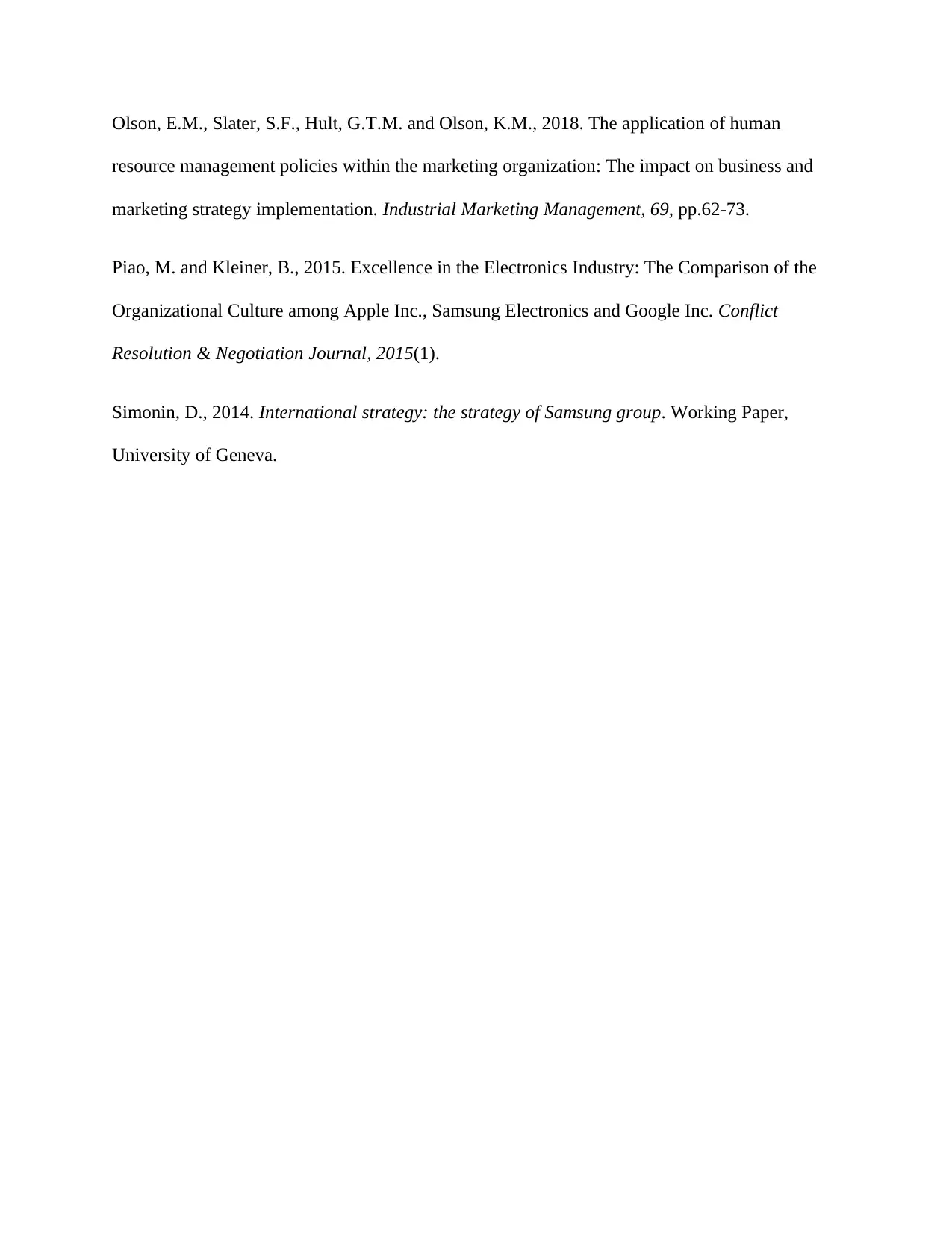
Olson, E.M., Slater, S.F., Hult, G.T.M. and Olson, K.M., 2018. The application of human
resource management policies within the marketing organization: The impact on business and
marketing strategy implementation. Industrial Marketing Management, 69, pp.62-73.
Piao, M. and Kleiner, B., 2015. Excellence in the Electronics Industry: The Comparison of the
Organizational Culture among Apple Inc., Samsung Electronics and Google Inc. Conflict
Resolution & Negotiation Journal, 2015(1).
Simonin, D., 2014. International strategy: the strategy of Samsung group. Working Paper,
University of Geneva.
resource management policies within the marketing organization: The impact on business and
marketing strategy implementation. Industrial Marketing Management, 69, pp.62-73.
Piao, M. and Kleiner, B., 2015. Excellence in the Electronics Industry: The Comparison of the
Organizational Culture among Apple Inc., Samsung Electronics and Google Inc. Conflict
Resolution & Negotiation Journal, 2015(1).
Simonin, D., 2014. International strategy: the strategy of Samsung group. Working Paper,
University of Geneva.
1 out of 10
Related Documents
Your All-in-One AI-Powered Toolkit for Academic Success.
+13062052269
info@desklib.com
Available 24*7 on WhatsApp / Email
![[object Object]](/_next/static/media/star-bottom.7253800d.svg)
Unlock your academic potential
Copyright © 2020–2025 A2Z Services. All Rights Reserved. Developed and managed by ZUCOL.





